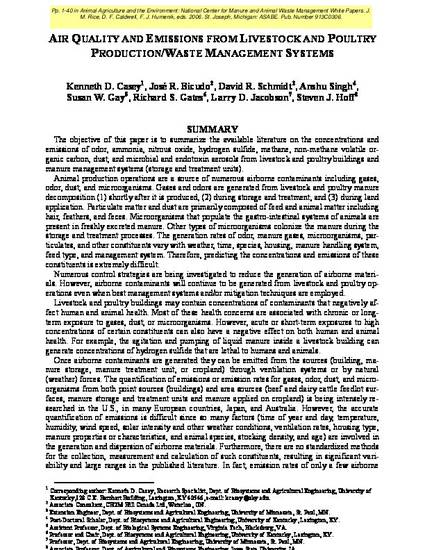
The objective of this paper is to summarize the available literature on the concentrations and emissions of odor, ammonia, nitrous oxide, hydrogen sulfide, methane, non-methane volatile organic carbon, dust, and microbial and endotoxin aerosols from livestock and poultry buildings and manure management systems (storage and treatment units).
Animal production operations are a source of numerous airborne contaminants including gases, odor, dust, and microorganisms. Gases and odors are generated from livestock and poultry manure decomposition (1) shortly after it is produced, (2) during storage and treatment, and (3) during land application. Particulate matter and dust are primarily composed of feed and animal matter including hair, feathers, and feces. Microorganisms that populate the gastro-intestinal systems of animals are present in freshly excreted manure. Other types of microorganisms colonize the manure during the storage and treatment processes. The generation rates of odor, manure gases, microorganisms, particulates, and other constituents vary with weather, time, species, housing, manure handling system, feed type, and management system. Therefore, predicting the concentrations and emissions of these constituents is extremely difficult.
Numerous control strategies are being investigated to reduce the generation of airborne materials. However, airborne contaminants will continue to be generated from livestock and poultry operations even when best management systems and/or mitigation techniques are employed.
Livestock and poultry buildings may contain concentrations of contaminants that negatively affect human and animal health. Most of these health concerns are associated with chronic or longterm exposure to gases, dust, or microorganisms. However, acute or short-term exposures to high concentrations of certain constituents can also have a negative effect on both human and animal health. For example, the agitation and pumping of liquid manure inside a livestock building can generate concentrations of hydrogen sulfide that are lethal to humans and animals.
Once airborne contaminants are generated they can be emitted from the sources (building, manure storage, manure treatment unit, or cropland) through ventilation systems or by natural (weather) forces. The quantification of emissions or emission rates for gases, odor, dust, and microorganisms from both point sources (buildings) and area sources (beef and dairy cattle feedlot surfaces, manure storage and treatment units and manure applied on cropland) is being intensely researched in the U.S., in many European countries, Japan, and Australia. However, the accurate quantification of emissions is difficult since so many factors (time of year and day, temperature, humidity, wind speed, solar intensity and other weather conditions, ventilation rates, housing type, manure properties or characteristics, and animal species, stocking density, and age) are involved in the generation and dispersion of airborne materials. Furthermore, there are no standardized methods for the collection, measurement and calculation of such constituents, resulting in significant variability and large ranges in the published literature. In fact, emission rates of only a few airborne contaminants have been investigated. Ammonia, hydrogen sulfide, and methane emissions have been more thoroughly studied than other gases and compounds because of the negative environmental impacts or human health concerns associated with them. Unfortunately, there is very little emission data for other contaminants such as odor, nitrous oxide, non-methane volatile organic compounds, dust, and endotoxins. The long-term impacts of these constituents on the environment and on human health are also not known.
Available at: http://works.bepress.com/steven_hoff/36/

This article is from Pp. 1-40 in Animal Agriculture and the Environment: National Center for Manure and Animal Waste Management White Papers. J. M. Rice, D. F. Caldwell, F. J. Humenik, eds. 2006. St. Joseph, Michigan: ASABE.